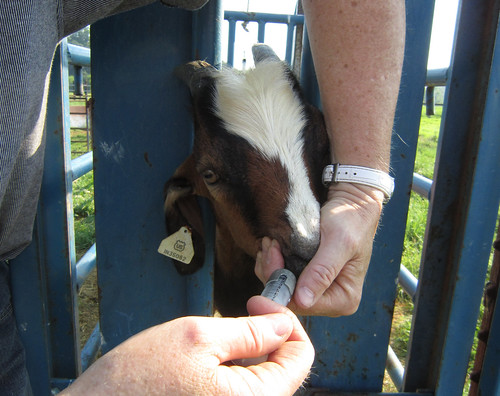Fecal egg counts from the samples collected from the goats on June 2 and June 14 demonstrated the effectiveness of the triple-dosing of dewormers.
No more worms
Among the 49 goats in the test, fecal egg count reduction (FECR) ranged from 88.9 to 100 percent and averaged 97.8 ±5.7 percent. The median reduction was 100 percent. FECR was similar for the goats in the pen vs. pasture study.
On June 14, fecal egg counts ranged from 0 to 467 epg and averaged 28 ±77 epg. The median egg count was 0 epg. Fecal egg counts on June 2 ranged from 0 to 15,150 eggs per gram (epg) and averaged 2,437 ±3337 epg. The median egg count was 1,257 epg.
On June 2, the goats were dewormed with moxidectin (Cydectin© @ 2 ml/11 lbs.), albendazole (Valbazen© @ 3 ml/50 lbs), and levamisole (Prohibit© at 3 ml/50 lbs.). Each of the dewormers used represented a different chemical class and mode of action. All of the dewormers were administered orally using a dosing syringe with a long metal nozzle. The drug was deposited into the goat's esophagus.
The triple-dosing achieved its objective: virtual "elimination" of worms (a few worms will always survive a treatment). For the comparisons in a performance test to be valid, all of the animals must start the test equally. The test officially started on June 14-15, when starting weights were determined and initial scores were collected. The 12-day adjustment period also allowed enough time for the goats to be cleared of worms.
Artificial dosing
Today, June 21, the test goats were dosed with 1,000 third stage (L3) larvae of Haemonchus contortus (barber pole worm). The larvae were mixed with water and given in the same manner as the dewormers. The larvae were provided by Dr. Anne Zajac's lab at Virginia Tech.
The purpose of the artificial dosing was NOT to challenge the goats (it's not enough larvae, plus the goats are "clean"), but rather to SEED the pastures with infective larvae; in other words, increase the probability that the goats will face a sufficient parasite challenge during the testing period. The larvae used are susceptible to all of the commonly-used anthelmintics.
As stated in previous blog entries, we cannot identify resistant and susceptible bucks unless the bucks are sufficiently challenged by parasites. A wide variation in fecal egg counts and FAMACHA© scores is necessary to get separation among the bucks. Lower egg counts are meaningless unless there are also high egg counts among many of the goats.
The goats will be worked next on June 28.
Download FECRT report
No more worms
Among the 49 goats in the test, fecal egg count reduction (FECR) ranged from 88.9 to 100 percent and averaged 97.8 ±5.7 percent. The median reduction was 100 percent. FECR was similar for the goats in the pen vs. pasture study.
 |
| As of 6/14, the goats were essentially "free" from worms |
On June 14, fecal egg counts ranged from 0 to 467 epg and averaged 28 ±77 epg. The median egg count was 0 epg. Fecal egg counts on June 2 ranged from 0 to 15,150 eggs per gram (epg) and averaged 2,437 ±3337 epg. The median egg count was 1,257 epg.
On June 2, the goats were dewormed with moxidectin (Cydectin© @ 2 ml/11 lbs.), albendazole (Valbazen© @ 3 ml/50 lbs), and levamisole (Prohibit© at 3 ml/50 lbs.). Each of the dewormers used represented a different chemical class and mode of action. All of the dewormers were administered orally using a dosing syringe with a long metal nozzle. The drug was deposited into the goat's esophagus.
The triple-dosing achieved its objective: virtual "elimination" of worms (a few worms will always survive a treatment). For the comparisons in a performance test to be valid, all of the animals must start the test equally. The test officially started on June 14-15, when starting weights were determined and initial scores were collected. The 12-day adjustment period also allowed enough time for the goats to be cleared of worms.
Artificial dosing
Today, June 21, the test goats were dosed with 1,000 third stage (L3) larvae of Haemonchus contortus (barber pole worm). The larvae were mixed with water and given in the same manner as the dewormers. The larvae were provided by Dr. Anne Zajac's lab at Virginia Tech.
 |
| Artificial dosing with worm larvae |
The purpose of the artificial dosing was NOT to challenge the goats (it's not enough larvae, plus the goats are "clean"), but rather to SEED the pastures with infective larvae; in other words, increase the probability that the goats will face a sufficient parasite challenge during the testing period. The larvae used are susceptible to all of the commonly-used anthelmintics.
As stated in previous blog entries, we cannot identify resistant and susceptible bucks unless the bucks are sufficiently challenged by parasites. A wide variation in fecal egg counts and FAMACHA© scores is necessary to get separation among the bucks. Lower egg counts are meaningless unless there are also high egg counts among many of the goats.
The goats will be worked next on June 28.
Download FECRT report











